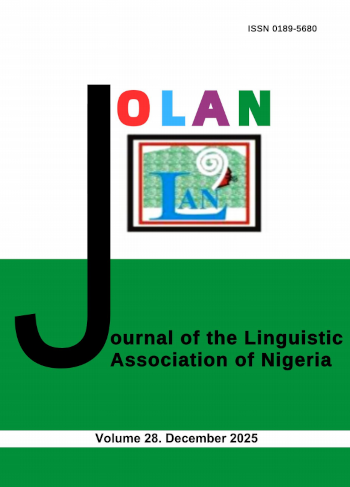A wordlist of Abureni on illnesses, diseases, and global pandemics
DOI:
https://doi.org/10.60787/jolan.vol27no1-2.397Keywords:
Abureni, illnesses, diseases, global pandemic, wordlistAbstract
The Abureni language is spoken along the southern borders of Bayelsa and Rivers States of Nigeria. It has names of common illnesses, diseases, and global pandemics that its people had suffered in the past, but they are not documented in any extant literature. The objective of this article is to address the identified gap by providing a wordlist on the diseases and illnesses in the Abureni language. The main tool for data elicitation was Roberts & Snider (2006)’s SIL Comparative African Wordlist (SILCAWL), from which illness and disease-related words were drawn and expanded. The data were presented in different linguistic domains and reviewed with selected native speakers, especially medical professionals. The author notes that during a global pandemic, native speakers used new language and interplay of words to describe the illness or disease that was prevalent. The interplay with words became more pronounced for novel diseases than for known types of diseases. It is anticipated that the results from this study will serve as resources to an Abureni wordlist or dictionary, thus minimizing the dearth of literature on Abureni disease names.
References
Akari, A. N. (2014). O̠nu̠ A̠b̠ureni 2014. GFP Publishers Enterprises & Grant Technologies.
Babaev, K. (2019). Reconstructing Benue-Congo person marking II. Journal of LanguageRelationship, 4,45. https://www.researchgate.net/publication/31373012_reconstructing_benue_congo_person_marking_ii
Balita-Centeno, L. (2020). 10 Pandemics Throughout History. World Facts. WorldAtlas. https://www.worldatlas.com/articles/10-pandemics-throughouthistory.html
Blench, R. (2008). The Central Delta languages: Comparative word list and historical reconstructions. Rogerblench.Info. https://www.rogerblench.info/Language/NigerCongo/BC/Cross%20River/Central%20Delta/Comparative%20Central%20Delta.pdf
Daniel, C. E. (2014). A history of Iduma from ancient times. Onyoma Research Publications.
Eberhard, D., Simons, G., & Fennig, C. (2021). Abureni language. Ethnologue: Languages of the World. SIL. https://www.sil.org/about/endangeredlanguages/languages-of-the-world
Ebua, V. T. (2017a). My mother tongue: Onu Ema Obagbony – Kugbo Book 1. Last Messenger Publication.
Ebua, V. T. (2017b). My mother tongue: Onu Ema Obagbony – Kugbo for Primary and Secondary Schools Book II. Last Messenger Publication.
Echerno, M. J. C. (2001). Igbo-English Dictionary. A comprehensive dictionary of the Igbo language with an English-Igbo Index. Longman Nigeria Plc.
Emenanjo, E. N., & Anyanwu, O. (2014). A comparative wordlist of another Five Igbo Dialects: Igbouzo, Azumini, Ngwa, Eziowele & Uturu. Ker Expert Books.
Etire, D. (2015). The orthography of the Abureni language. Onyoma Research Publications.
Etire, D. (2016). O̠nu̠ Áb̠ùrénì 1. Onyoma Research Publications.
Etire, D. (2017). O̠nu̠ A̠b̠ureni: I̠nu̠e̠ma, Ooba na̠ aso̠r – Abureni poetry: Expressions, Folktales and lyrics. Onyoma Research Publications.
Etire, D. (2023). A wordlist of Abureni. Onyoma Research Publications.
Etire, D., & Etire, P. D. (2023). Ilom A̠b̠ureni “Abureni marriage tradition” Bilingual. Onyoma Research Publications.
Faraclas, N. (1989). The Cross River languages. In Bendor-Samuel, J. (Ed.), The Niger Congo languages (pp.277-394). University Press of America.
George, T., & Mercus, J. (2023). Structured interview: Definition, guide and examples. Scribbr. https://www.scribbr.com/methodology/structured-interview/
Ianna, B. P. (2017). A knowledge-based approach in the conceptualization of disease in Tiv for a more effective health communication. Journal of Linguistic Association of Nigeria, 20(1), 47-55.
https://jolan.com.ng/index.php/home/issue/view/3https://jolan.com.ng/index.php/home/article/view/55
Jobes, K. H. (2007). Relevance theory and the translation of scripture. Journal of the Evangelical Theological Society, JETS, 50(4), 773-797. https://etsjets.org/wpcontent/uploads/2010/06/files_JETS-PDFs_50_50-4_JETS_50-4_773-0797_Jobes.pdf
Macleod, S. (2024). The interview method in psychology. Simply Psychology. https://www.simplypsychology.org/interviews.html
Ndimele, O., Kari, E. E., & Ayuwo, J. G. I. (2009). Language: Some historical implications. In E. J. Alagoa, T. N, Tamuno, & J, P, Clark. (Eds.), The Izon of the
Niger Delta. (pp. 69-89). Onyoma Research Publications. Newton, G., & Esling, J. (2015, July 1). Full IPA chart. International Phonetic. Association. https://www.internationalphoneticassociation.org/content/full-ipachart
Nigerian Educational Research and Development Council (2022, November 30). National Language Policy. Retrieved July 26, 2024, from https://www.nerdc.gov.org.
National Language Policy. (2022, November 30). Nigerian Educational Research and Development Council. https://www.nerdc.gov.org
Obikudo, E. F., & Obi-Okolo, B. C. (2022). The vowel system of Àlége. Arusha Working Papers in African Linguistics, 4(1), 3-20.
Porta, M. (2016, April 20). Pandemic. A dictionary of epidemiology. Oxford Reference. https://www.oxfordreference.com/display/10.1093/acref/9780199976720.001.0001/acref-9780199976720-e-1373
Robert, P. (2019). History of Emago Kugbo. Performance Printing Ventures.
Roberts, J., & Snider, K. (2006). Typological tools for field linguistics: SIL Comparative African Wordlist (SILCAWL). Max Planck Institute. https://www.eva.mpg.de/lingua/tools-atlingboard/pdf/Snider_silewp2006-005.pdf
Rogers, K. (2020). Who can declare a pandemic and what criteria are required for an outbreak to be called a
pandemic? Britannica. https://www.britannica.com/story/who-can-declare-apandemic-and-what-criteria-are-required-for-an-outbreak-to-be-called-apandemic
Sanders, R. E. (2008). Dan Sperber and Deirdre Wilson, Relevance: Communication and cognition, Basil Blackwell, https://doi.org/10.1017/S004740450001318X
Shatz, I. (2016). Grice’s Maxims of Conversation: The Principles of Effective Communication. Effectiviology. https://effectiviology.com/principles-ofeffective-communication/
Tiwari, T. S. P., Moro, P. L., & Acosta, A. M. (2024). Chapter 21: Tetanus. Epidemiology and Prevention of Vaccine- Preventable Diseases. https://www.cdc.gov/pinkbook/hcp/table-of-contents/chapter-21-tetanus.html.
Udoh, I. I. L., & Okon, B. A. (2008). The languages of the Niger Delta Region of Nigeria. Concept Publications.
Williamson, K. (1989). Benue-Congo Overview. In Bendor-Samuel, J. (Ed.), The NigerCongo languages (pp. 246-274). University Press of America.
World Health Organization. (2023). Pandemic and epidemic-prone diseases. OpenWHO.org. https://openwho.org/courses/pandemic-epidemic-diseases
Downloads
Published
How to Cite
Issue
Section
License
Copyright (c) 2024 Journal of The Linguistic Association of Nigeria

This work is licensed under a Creative Commons Attribution-NonCommercial-ShareAlike 4.0 International License.













